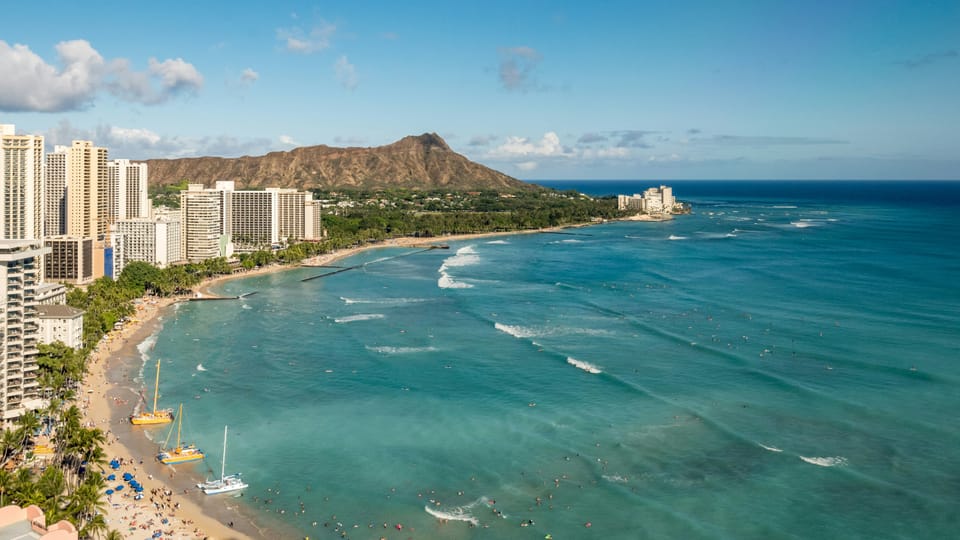Ocean Paddling: Reading the Elements

Wave, Tide, Swell and Wind Conditions for Waikīkī
Understanding and respecting the ocean's dynamic nature is crucial. Wave, tide, wind, and weather conditions directly impact our paddling experience, influencing everything from our route planning to our paddling technique.
Let's delve into the importance of each element.
Waves
- Size and Shape: Wave size determines the level of challenge and potential danger. Small, rolling waves offer a gentle experience, while large swells require experience and strong paddling skills. The shape of the wave, whether it's a breaking wave, a spilling wave, or a surging wave, also dictates how we approach it.
- Direction: Waves rarely come directly head-on or from behind. Understanding the angle of the waves allows us to adjust our course and paddling technique for efficient and safe passage.
- Frequency: The time interval between waves, known as the wave period, is crucial for timing maneuvers and navigating the surf zone.
Tides
- Tidal Currents: Paddling against a strong outgoing tide can be exhausting, while an incoming tide can give us a helpful boost. Understanding tidal currents is essential for planning our route and estimating paddling times.
- Water Level: Tides affect water depth, exposing or submerging hazards like reefs or rocks. Knowing the tide tables helps us avoid these dangers and choose appropriate launch and landing sites.
Swell
- Definition and Origin: Swell refers to the long-period waves that have travelled far from their origin, often generated by distant storms. Unlike wind-driven waves, swells are more organized and uniform, rolling in with a consistent pattern.
- Impact on Paddling: Swell adds another layer of complexity to paddling conditions. Depending on the size and direction of the swell, it can create challenging conditions even on a calm day. Paddling against a large swell demands considerable effort and skill, while surfing down a swell can be exhilarating.
- Interaction with Other Elements: Swell interacts with local wind and tides, creating complex wave patterns. For example, an opposing wind can make the swell steeper and more challenging, while a following wind can create long, rolling waves ideal for surfing.
Additional Considerations Regarding Swell
- Refraction and Diffraction: Swell can bend around headlands and islands, creating unexpected wave patterns and currents.
- Breaking Swell: When swell reaches shallow water, it can break, forming powerful waves that require careful navigation.
- Rip Currents: Swells can contribute to the formation of rip currents, which are strong currents heading away from shore. Understanding how to identify and escape rip currents is essential for ocean safety.
Wind
- Strength and Direction: Wind directly impacts our speed and effort. A headwind creates resistance, demanding more power, while a tailwind provides a welcome push. Understanding wind direction helps us plan our route to utilize favorable winds and avoid battling strong headwinds.
- Wind Gusts: Sudden bursts of wind can destabilize the canoe, requiring quick adjustments to maintain balance and control.
Weather Conditions
- Visibility: Fog, rain, or storms can significantly reduce visibility, making navigation and communication challenging.
- Temperature and Sun Exposure: Paddling in extreme heat or cold requires proper preparation and hydration. Sun protection is crucial on sunny days.
- Lightning: Open water and a canoe's elevated position make us vulnerable to lightning strikes. It's crucial to seek shelter immediately if there is any risk of lightning.
Additional Considerations
- Local Knowledge: Consulting with experienced paddlers and lifeguards familiar with the area provides invaluable insights into specific hazards and conditions.
- Safety Gear: Always wear a personal flotation device and carry essential safety equipment, including a whistle, marine radio, and first-aid kit.
- Paddling with a Team: Paddling with experienced companions enhances safety and allows for shared knowledge and support.
By understanding and respecting the interplay of waves, tides, wind, and weather, outrigger canoe paddlers can enjoy safe and rewarding experiences on the ocean.
Remember, the ocean is a powerful force, and it's crucial to approach it with humility and caution.
